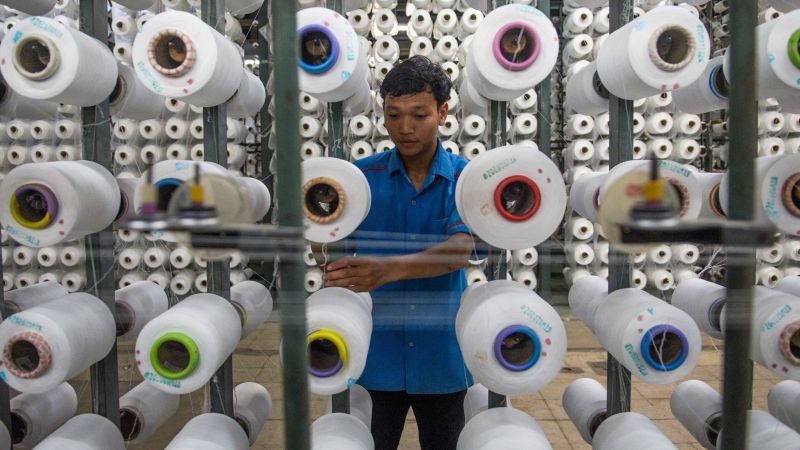Over the past decade, the rapid increase in U.S. tariffs on Chinese imports has prompted both foreign and Chinese companies to turn their attention toward South and Southeast Asia as new hubs for their supply chains. This shift allows firms to mitigate the impacts of tariffs and instigate diversification. However, under the administration of former President Donald Trump, who heavily promoted a protectionist agenda, these nations have encountered significant challenges. The latest trade policies have added higher tariffs to an already intense international trade climate, affecting not only local economies but also potentially increasing costs for American consumers.
In response to the recently released tariff figures, many South and Southeast Asian leaders publicly reacted with optimism, suggesting that the rates were lower than what had initially been forecasted by the Trump administration. For instance, leaders from countries like Cambodia and Malaysia pointed out that while the new tariffs are substantial, they are less daunting than initially expected. Nonetheless, experts caution that the new tariff structures remain steep, and such an outlook could be misleading. Dan Ives, global head of research at Wedbush Securities, describes the tariffs as a significant financial blow to these nations. He believes that the U.S. is attempting to limit China’s export options by imposing these high tariffs, particularly targeting countries in Asia that trade with both the U.S. and China.
Another critical issue impacting regional economies is the additional 40% tariff on “transshipments,” which refers to goods transferred from a high-tariff country to a low-tariff country before being exported to the U.S. This new measure has raised concerns among businesses, complicating supply chains further. South and Southeast Asia is seen as a strategic battleground between the U.S. and China, with rapid economic development and a growing middle-class populace creating a competitive landscape that is vital for manufacturing and exports.
As China’s President Xi Jinping embarked on diplomatic missions to Southeast Asia early in the ongoing trade conflict with the U.S., he positioned China as a dependable trade partner amidst rising U.S. tensions. The historical context of this trade war, exacerbated by the COVID-19 pandemic, has led several regional economies to evolve into export-driven platforms, intentionally recruiting global and Chinese investments as alternatives to China itself.
However, with the escalation of Trump’s tariffs—including significant rates imposed upon countries such as Laos and Myanmar—local economies are now confronted with steep financial pressures. While the tariffs were ultimately established at lower rates for many Southeast Asian nations, their implications are still severe. For example, Cambodia and Malaysia both face rates of 19%, while Bangladesh is subject to 20%. Despite positive public statements from regional leaders celebrating these relatively lower rates compared to the “Liberation Day” threatened tariffs, analysts like Deborah Elms from the Hinrich Foundation argue that such views may be overly optimistic. Elms asserts that these tariffs are indeed burdensome and ultimately detrimental to both American consumers and the economies of countries reliant on exports.
Moreover, these nations face the challenge of transshipment tariffs which create layers of bureaucracy for businesses focused on global trade. The Trump administration’s broad definition of transshipment, heavily focused on potential Chinese content, adds further uncertainty regarding which goods may be taxed and how such classifications will be enforced. This ambiguity generates anxiety among manufacturers and traders as it threatens the ability to efficiently navigate international markets.
The long-term effects of these tariffs will likely reshape the supply chains of South and Southeast Asia significantly. Some experts, such as Louise Loo of Oxford Economics, predict that there will be evasions or rerouting strategies employed by firms to navigate these tariffs, potentially leading to a drop in U.S.-bound trade. As manufacturing firms confront these punitive tariffs, industries characterized by low labor costs may consider relocating back to China to capitalize on economies of scale, while others may explore markets closer to the U.S. to mitigate shipping challenges.
Despite the administration’s aim to staunch the flow of goods from China, trade experts maintain that the overarching trend of offshoring manufacturing from China to the surrounding regions may persist. Lynn Song of ING notes that while tariffs impose a temporary hindrance to manufacturing, the broader competitive forces in the region—such as rising labor costs in China—will likely continue to drive investments elsewhere, particularly in countries that remain cost-competitive despite the challenges posed by tariffs.
In conclusion, the U.S.’s heightened tariff regime under Trump has not only created immediate economic ramifications for South and Southeast Asia but may also incentivize long-term strategic changes in global trade and supply chain structures. As countries grapple with the implications of these tariffs, the interplay between national interests, corporate considerations, and geopolitical shifts will continue to evolve, setting the stage for a complex future in international commerce.











